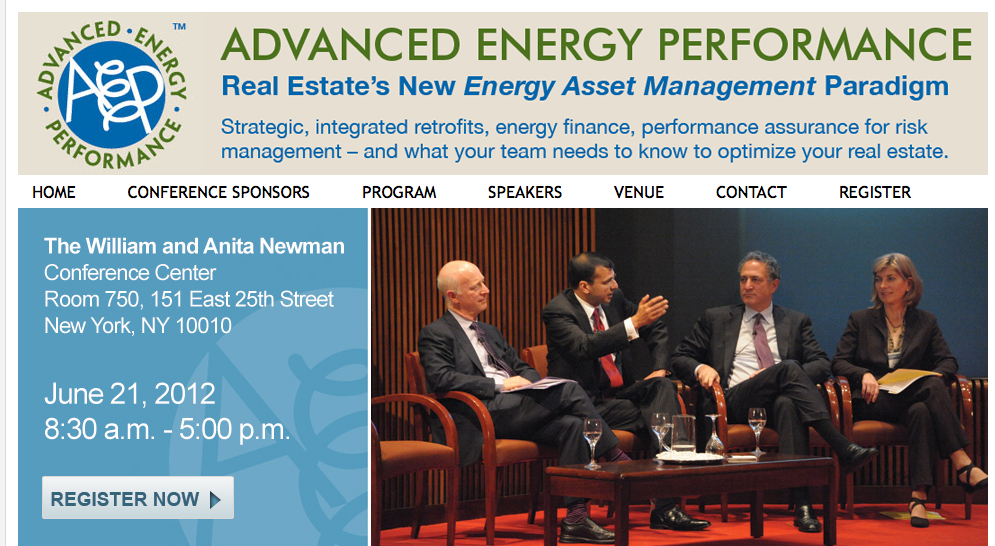Baruch College and the Steven L. Newman Real Estate Institute, together with the CUNY Institute for Urban Systems Building Performance Lab, will host an inaugural day-long conference Thursday, June 21, 2012, to introduce Energy Asset Management, a compelling high-yield approach that views energy comprehensively, across an entire portfolio of buildings.
“The industry is ready for the next step,” said Jack S. Nyman, NREI’s director and host of the event. “Operational efforts to save energy in individual commercial buildings have become routine. Operations have to be viewed in their totality if true efficiencies and substantial cost-effectiveness are to be realized. This conference will show property owners, their managers, and real estate asset managers how.”
NREI research – supported by the U.S. Department of Energy [U.S. DOE] and the New York State Energy Research & Development Authority revealed that top-level real estate professionals have been ignored as the industry has pushed to get sustainability measures in place. “The focus was on the boiler room, but true yield comes at the boardroom level,” Mr. Nyman stated.
Topics at the conference, which will take place at Baruch College’s William and Anita Newman Conference Center, 151 East 25th Street, will address how to:
- Execute integrated retrofits to ensure long-term energy savings
- Implement energy performance assurance
- Identify the best emerging practices in O&M
- Create informative, useful financial models
- Navigate and interpret energy audits
- Satisfy ever-increasing regulatory compliance
- Train the green team
- Develop solutions to the split incentive
Conference funding reflects wide industry interest in Advanced Energy Performance, Energy Asset Management, and NREI’s leadership in sustainability training. The conference is registered with the American Institute of Architects, ASHRAE Continuing Education, and BOMI International, which will give attendees continuing education credits for participating.
Go to http://aepconference.com/ for more information. Registration begins at 8 a.m. The conference closes at 5 p.m. +
Related Stories
Architects | May 2, 2024
Emerging considerations in inclusive design
Design elements that consider a diverse population of users make lives better. When it comes to wayfinding, some factors will remain consistent—including accessibility and legibility.
K-12 Schools | Apr 30, 2024
Fully electric Oregon elementary school aims for resilience with microgrid design
The River Grove Elementary School in Oregon was designed for net-zero carbon and resiliency to seismic events, storms, and wildfire. The roughly 82,000-sf school in a Portland suburb will feature a microgrid—a small-scale power grid that operates independently from the area’s electric grid.
AEC Tech | Apr 30, 2024
Lack of organizational readiness is biggest hurdle to artificial intelligence adoption
Managers of companies in the industrial sector, including construction, have bought the hype of artificial intelligence (AI) as a transformative technology, but their organizations are not ready to realize its promise, according to research from IFS, a global cloud enterprise software company. An IFS survey of 1,700 senior decision-makers found that 84% of executives anticipate massive organizational benefits from AI.
Codes and Standards | Apr 30, 2024
Updated document details methods of testing fenestration for exterior walls
The Fenestration and Glazing Industry Alliance (FGIA) updated a document serving a recommended practice for determining test methodology for laboratory and field testing of exterior wall systems. The document pertains to products covered by an AAMA standard such as curtain walls, storefronts, window walls, and sloped glazing. AAMA 501-24, Methods of Test for Exterior Walls was last updated in 2015.
MFPRO+ News | Apr 29, 2024
World’s largest 3D printer could create entire neighborhoods
The University of Maine recently unveiled the world’s largest 3D printer said to be able to create entire neighborhoods. The machine is four times larger than a preceding model that was first tested in 2019. The older model was used to create a 600 sf single-family home made of recyclable wood fiber and bio-resin materials.
K-12 Schools | Apr 29, 2024
Tomorrow's classrooms: Designing schools for the digital age
In a world where technology’s rapid pace has reshaped how we live, work, and communicate, it should be no surprise that it’s also changing the PreK-12 education landscape.
Adaptive Reuse | Apr 29, 2024
6 characteristics of a successful adaptive reuse conversion
In the continuous battle against housing shortages and the surplus of vacant buildings, developers are turning their attention to the viability of adaptive reuse for their properties.
AEC Innovators | Apr 26, 2024
National Institute of Building Sciences announces Building Innovation 2024 schedule
The National Institute of Building Sciences is hosting its annual Building Innovation conference, May 22-24 at the Capital Hilton in Washington, D.C. BI2024 brings together everyone who impacts the built environment: government agencies, contractors, the private sector, architects, scientists, and more.
Mass Timber | Apr 25, 2024
Bjarke Ingels Group designs a mass timber cube structure for the University of Kansas
Bjarke Ingels Group (BIG) and executive architect BNIM have unveiled their design for a new mass timber cube structure called the Makers’ KUbe for the University of Kansas School of Architecture & Design. A six-story, 50,000-sf building for learning and collaboration, the light-filled KUbe will house studio and teaching space, 3D-printing and robotic labs, and a ground-level cafe, all organized around a central core.
Sports and Recreational Facilities | Apr 25, 2024
How pools can positively affect communities
Clark Nexsen senior architects Jennifer Heintz and Dorothea Schulz discuss how pools can create jobs, break down barriers, and create opportunities within communities.

















